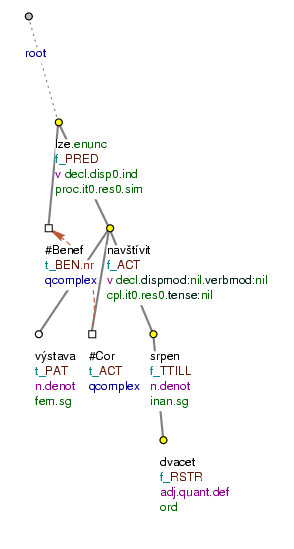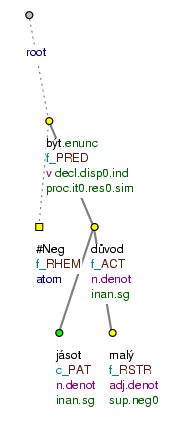We suppose that the resulting order of nodes in tectogrammatical trees is projective. Projectivity is defined as follows: if two nodes M and N are connected by an edge and M is to the left from N, then all nodes to the right from M and to the left from N are connected with the root via a path that passes through at least one of the nodes M and N. In short: between a mother and its direct daughter there can be only direct or indirect daughters of the mother.
In the surface structure of the sentence, due to various causes there occur word order transformations that lead to surface-structure non-projectivity. We suppose that non-projectivity in the surface structure of sentences is caused by word-order movements and that such non-projective surface realizations correspond to projective tectogrammatical structures. During the tectogrammatical annotation, we therefore projectivize such constructions.
By projectivization we mean modifying the underlying order of a node (causing the non-projectivity) so that no node of the resulting tectogrammatical tree violates the definition of projectivity.
When carrying out the projectivization we take into account the motivation of the particular word-order movement. Presently we distinguish three types of motivations:
-
non-projectivities motivated by word-order rules (see Section 3.4.1, "Non-projectivities motivated by word-order rules"),
-
non-projectivities motivated by prosodic reasons (see Section 3.4.2, "Non-projectivities motivated by prosodic reasons"),
-
non-projectivities motivated by the topic-focus articulation (see Section 3.4.3, "Non-projectivities motivated by the topic-focus articulation").
A non-projectivity can be motivated by the fixed position of an expression in the surface word order. This applies mainly to nominal groups, which can be non-projective due to the position of a more deeply embedded modification (further modified adjectival modifications before the governing noun), to dependent clauses introduced by adjectival relative words that are moved away from their governing nouns, and to other phrasemes (idioms) that have frozen non-projective word-order forms.
In constructions of this type, we carry out the projectivization depending on which expression is causing the non-projectivity:
-
if a relative adjectival expression modifying a noun in a subordinate clause, the node representing this expression, depending on its contextual boundness, i.e. its
tfavalue, is moved into a projective position either to the left (tfa=t) or to the right (tfa=f) from its governing node.Compare:
-
Ptal jsem se ho, JAKÉHO [
tfa=f] si koupil psa. (=lit. (I) asked _ _ him what himself bought dog.ACC.)The relative adjectival expression jakého (=what) (the bearer of the intonation centre) is moved away from its governing noun psa (=dog.ACC), and so causes a non-projectivity. In the tectogrammatical tree, the node representing this expression is moved to a projective position to the right from the governing node (see also the annotation of indirect questions - Section 4.4.3, "Topic-focus articulation of indirect questions").
-
Řekl mi, jakou [
tfa=t] si přeje KNIHU. (=lit. (He) told me what he wants book.ACC.)The relative adjectival expression jakou (=what) is moved away from its governing noun knihu (=book.ACC) (the bearer of the intonation centre) and causes a non-projectivity. In the tectogrammatical tree, the node representing this expression is moved to a projective position to the left from the governing node.
-
-
if a further modified adjectival expression is moved non-projectively to the left, we proceed according to whether the expression constitutes a quasi-focus (see Section 3.1.2, "Quasi-focus"). In case the adjectival expressions fulfills the function of a quasi-focus (a modification of the contextually bound adjective is contextually non-bound), in the tectogrammatical tree we place the node representing the adjectival expression to the right from its governing node (representing a noun) and to the left from its dependent node. In case the adjectival expressions does not fulfill the function of a quasi-focus (the modification of the adjective is contextually bound), we move the node representing the dependent modification of the adjective to a projective position, according to its value of contextual boundness (
tfavalue) either to the left (tfa=t) or to the right (tfa=f) from its governing node.Compare:
-
Měl plné [
tfa=t] kapsy peněz [tfa=f] (=lit. (He) had full pockets of_money.)The modified adjective plné (=full) is moved away from its dependent modification peněz (=of_money) and causes a non-projectivity. Since it fulfills the function of quasi-focus, in the tectogrammatical tree we place the node representing this adjective to the right from its governing node (representing the noun kapsy (=pockets) ) and to the left from its dependent node (representing the modification peněz (=of_money) ).
-
(Měl plné ruce peněz.) Ne, měl plné [
tfa=t] KAPSY peněz [tfa=t] (=lit. ((He) had full hands of_money.) No, (he) had full pockets of_money.)The modified adjective plné (=full) is moved away from its dependent modification peněz (=of_money) and causes a non-projectivity. Because it does not fulfill the function of a quasi-focus, in the tectogrammatical tree we place the node representing this adjective to the left from its governing node (representing the noun kapsy (=pockets) ) and we move the node representing the dependent modification of this adjective (the noun peněz (=of_money) ) to the projective position to the left from its governing node.
This type of deviation of the surface word order from projectivity is common in constructions of comparison (see Section 4, "Constructions with the meaning of "comparison""); e.g.:
Paříž je větší město než Praha. (=lit. Paris is (a) bigger city than Prague.)
Kolín je stejně velké město jako Chrudim. (=lit. Kolín is equally big town as Chrudim.)
-
In Czech, there is a set of unstressed expressions (so-called clitics) that always take "the second position" in the sentence (i.e. the position after the first prosodic unit). In case these expressions are not direct dependents of the governing verb of the clause, they can cause non-projectivity.
Clitic words are usually contextually bound, they are therefore assigned the tfa value t and are placed at projective positions according to the guidelines for the ordering of contextually bound nodes (see Section 3.2.2, "Ordering of contextually bound nodes in verbal groups").
Compare:
-
Konečně [
tfa=f] se to [tfa=t] podařilo [tfa=f] uskutečnit [tfa=f] (=lit. Finally _ it succeeded accomplishing.)In the surface word order, the clitic to (=it) (the Patient of the verb uskutečnit (=accomplishing) ) is moved away to the left due to prosodic reasons. In the tectogrammatical tree, we place the contextually bound node representing this clitic projectively to the left from the node representing the verb uskutečnit (=accomplishing) .
In Czech, contrastive contextually bound expressions (see Section 2.2.2, "Contrastive contextually bound expression (value c in attribute tfa)") have a strong tendency towards standing at the initial position in the sentence, that means that they move to the left although they are more deeply embedded, and so can cause non-projectivities.
In the tectogrammatical tree, a node representing an expression that is placed non-projectively in the surface word-order due to its contrastive usage (tfa = c) is placed according to the guidelines in Section 3.2.2, "Ordering of contextually bound nodes in verbal groups" and Section 3.3, "Ordering of nodes in nominal groups (noun phrases)" projectively leftmost possible.
Compare:
-
K jásotu [
tfa=c] není [tfa=f] nejmenší [tfa=f] důvod [tfa=f] (=lit. For cheering there_is_not the_slightest reason.)The modification k jásotu (=for cheering) (the Patient of the noun důvod (=reason) ) is moved left to the initial position in the surface word order due to its contrastive usage. In the tectogrammatical tree, we place the contrastive contextually bound node representing this modification projectively to the left from the node representing the noun důvod (=reason). Cf. Fig. 10.11.
In addition to cases in which the motivation for the non-projectivity is clear, there are also cases where the motivation of the word-order movement is not obvious, and furthermore in some of these cases the non-projective surface word-order form of the sentence is the unmarked form.
This applies mainly to dependent modifications of multi-word predicates: a contextually bound expression standing to the left from a multi-word expression and dependent on the dependent part of this expression causes a non-projectivity (even though it is not contrastive; see Section 3.4.3, "Non-projectivities motivated by the topic-focus articulation").
In the tectogrammatical tree, multi-word predicates are usually represented by two nodes (see Section 9, "Multi-word predicates"). The node causing the non-projectivity depends on the node representing the dependent part of the multi-word predicate. Presently we know about the following types of non-projective non-contrastive contextually bound nodes:
-
the node causing the non-projectivity depends on the node representing the nominal part of a complex predicate (on a node with functor
CPHR; for complex predicates see Section 9.3, "Complex predicates"), -
the node causing the non-projectivity depends on the node representing the infinitive of the substantive verb in a modal or phase predicate represented by two nodes (see Section 9.1, "Modal and phase predicates"),
-
the node causing the non-projectivity depends on the node representing the non-verbal part of a quasi-modal or quasi-phase predicate (see Section 9.2, "Quasi-modal and quasi-phase predicates"),
-
the node causing the non-projectivity depends on the node representing the non-verbal part of a verbonominal predicate (see Section 2.1.3, "Copula "být" (verbonominal predicate)"),
-
the node causing the non-projectivity depends on the node representing the dependent part of a phraseme (idiom) (see Section 8.2, "Verbal idioms").
In the above-mentioned cases we encounter the following problem. If we projectivize the contextually bound node, on the tectogrammatical level we cannot distinguish a surface word-order projective sentence from a surface word-order non-projective sentence with the same words. Therefore, if we stipulated a single tectogrammatical representation for both these realizations, we would stipulate a single meaning for them - which we dare not claim. Because of this we decided that in order to preserve the information about the original position of the expressions, the node representing the non-projective non-contrastive contextually bound expression will stay at a position corresponding to its surface word-order position, it is not moved to the right and the resulting tectogrammatical tree therefore contains a non-projective edge, which allows us to distinguish both variants and to study them further.
Compare:
-
(V galerii V. Špály ode dneška vystavuje A. Born.) Výstavu [
tfa=t] lze navštívit do dvacátého srpna. (=lit. (In (the) gallery of_V. of_Špála from today exhibits A. Born.) (The) exhibition can be_visited until the_twentieth of_August.)The contextually bound modification výstavu (=exhibition) (the Patient of the verb navštívit (=to_visit) ) is moved to the left in the surface word order. In the tectogrammatical tree, the node representing this non-projective non-contrastive contextually bound expression is in a position corresponding to the surface word order, it is not moved to the right. Cf. Fig. 10.12.
Figure 10.12. A non-projective tectogrammatical tree

(V galerii V. Špály ode dneška vystavuje A. Born.) Výstavu lze navštívit do dvacátého srpna. (=lit. (In (the) gallery of_V. of_Špála from today exhibits A. Born.) (The) exhibition can be_visited until the_twentieth of_August.)
!!! This is a provisional solution, which will be replaced by projective structures as soon as we elaborate on different degrees of multi-word predicates.
!!! All tectogrammatical trees in PDT 2.0 that remain non-projective are non-projective because of the above-mentioned reasons. However, there are tectogrammatical trees that have been projectivized that should have been annotated as non-projective according to the just mentioned instructions.
